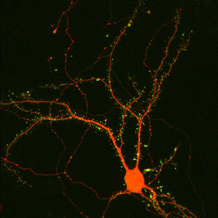
In the amygdala, neurons (red) communicate with each other to control fear using tiny junctions called synapses (green) where the "trauma switch" receptors are located.
Breakthrough study identifies 'trauma switch'
Researchers from the University of Exeter Medical School have for the first time identified the mechanism that protects us from developing uncontrollable fear.
Our brains have the extraordinary capacity to adapt to changing environments – experts call this ‘plasticity’. Plasticity protects us from developing mental disorders as the result of stress and trauma.
Researchers found that stressful events re-programme certain receptors in the emotional centre of the brain (the amygdala), which the receptors then determine how the brain reacts to the next traumatic event.
These receptors (called protease-activated receptor 1 or PAR1) act in the same way as a command centre, telling neurons whether they should stop or accelerate their activity.
Before a traumatic event, PAR1s usually tell amygdala neurons to remain active and produce vivid emotions. However, after trauma they command these neurons to stop activating and stop producing emotions – so protecting us from developing uncontrollable fear.
This helps us to keep our fear under control, and not to develop exaggerated responses to mild or irrelevant fear triggers – for example, someone who may have witnessed a road traffic accident who develops a fear of cars or someone who may have had a dog jump up on them as a child and who now panics when they see another dog.
The research team used mice in which the PAR1 receptors were genetically de-activated and found that the animals developed a pathological fear in response to even mild, aversive stimuli.
The study was led by Professor Robert Pawlak of University of Exeter Medical School. He said: “The discovery that the same receptor can either awaken neurons or ‘switch them off’ depending on previous trauma and stress experience, adds an entirely new dimension to our knowledge of how the brain operates and emotions are formed.”
Professor Pawlak added: “We are now planning to extend our study to investigate if the above mechanisms, or genetic defects of the PAR1 receptor, are responsible for the development of anxiety disorders and depression in human patients. There is more work to be done, but the potential for the development of future therapies based on our findings is both exciting and intriguing.”
The article describing the above findings has recently been published in one of the most prestigious psychiatry journals, Molecular Psychiatry.
Date: 8 October 2012
